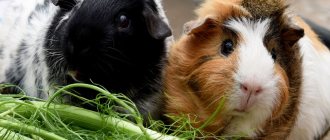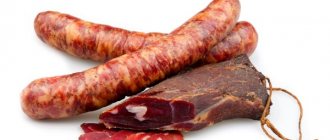For many people, a guinea pig is a cute and fluffy pet. Few people know that the history of domestication and breeding began with the use of the guinea pig as a meat animal.
In some countries, even today, fried guinea pig is a traditional and quite common dish, and in the European and US markets, the meat of this animal is a delicacy.
How to cook guinea pigs
For us, a guinea pig is a deliberately inedible decorative pet.
But for residents of Peru, most of Ecuador, Colombia and Bolivia, it is the main food pet. In Peru and Ecuador, every house always has at least five guinea pigs. Moreover, there are no separate or special premises for keeping guinea pigs in houses. Animals roam freely throughout the house, gathering twice a day in a designated feeding area. In Peru, with a population of 30 million, the number of guinea pigs reaches 120 million. And more than 600 million of them are consumed per year. This number of guinea pigs is due to their high reproductive rate and unpretentiousness. Every seventy days, a female guinea pig gives birth to a litter of ten babies. Cooking guinea pigs is very simple. Even easier than chicken. I recommend three traditional Peruvian recipes. Country-style guinea pig
We observed how in the port of Iquitos on the Amazon River, Peru, local residents prepared guinea pigs for themselves in a very simple and original way. Wash the skinned and gutted guinea pig carcass well. Cut off the head and ends of the paws. Although, if you're not an amateur, you can cook with your head. Place the carcass on a cutting board and lightly beat it. Salt and spices to taste. In Peru, in the port of Iquitos, longshoremen and just local residents prepared guinea pigs in this way for breakfast, lunch, and dinner, having previously peppered them heavily with ground red, terribly hot local pepper. Tie the paws with thick cotton (or wool or hemp) threads to the crossbars of a double cross made of wooden sticks:
Stick the long end of the cross with the carcass tied to it into the ground near a hole with hot charcoals, tilting it 45-60 degrees towards the coals. Cook like this for about 15-20 minutes, turning the carcass to the coals with the other side every two minutes.
Spotted in the port of Iquitos on the Amazon River, Peru, in a small port restaurant. Rinse skinned and gutted guinea pig carcasses well. Cut off the heads and ends of the paws. Cut each carcass into four parts: first along the ridge, then across (you can do it the other way around). Place in a large cast iron casserole. Add pre-soaked beans. For five kilograms of carcass weight - a half-liter can of dry beans. The color and size of the beans does not matter. But in Peru, for us, pigs were cooked with local, very large (the size of a peach pit) anthracite-black beans. You can add either young or canned corn instead of beans. Approximately the same quantity in terms of volume. Salt and spices - to taste. Pour boiling water over everything, stir and put on fire. As soon as the water boils, reduce the heat, mix everything again and simmer for an hour, periodically adding boiling water as it boils. Before each addition of water, mix everything.
This method was observed in the same port of Iquitos. Some local outcasts prepared their pigs in this way; judging by their huge noses, they were descendants of the Incas. A freshly slaughtered, so to speak, guinea pig, without gutting or skinning, is coated with a centimeter layer of ordinary clay. Allow the clay to dry for an hour. During this time, in a hole dug in the ground half a meter deep and the same diameter, a fire is lit using large branches and small logs. In an hour, a full hole of hot coals burns up. The coals are raked, 5-7 pre-cooked carcasses coated with clay are placed on their surface and covered with coals. More firewood is placed on top. And cook like this for 2-4 hours. The finished guinea pig carcasses baked in clay are taken out of the coals and thrown into a bucket of cold water until the hot clay cracks. The clay is split, and inside is UNION! I was told that in some areas of Peru and Ecuador, pigs are prepared in this way, by being walled alive in clay. It is believed that it tastes better this way.
Source
Dolphin
Dolphin meat is also consumed in Japan, but unlike whale meat it is a very rare delicacy, eaten in the small Japanese city of Taiji, in the south of the island of Honshu. Most Japanese have never even tried it, since hunting animals is prohibited. However, they often swim into the bay, where poachers block them and then kill them. Activists regularly stage protests and speak out against the killing of dolphins.
How to cook guinea pig
In Peru they love to cook guinea pig and eat 65 million of these animals every year. However, these are not those cute guinea pigs - creatures from a pet store, but thick, up to 4 kg, and up to 40 cm long Kui pigs. They are cheap, bear offspring once every 70 days, and a good one will grow to adulthood in a year. Kuy tastes like suckling pig with tender and lean meat and a crispy baked crust.
Foie gras
As with veal, there has been much outrage over the farming practices of birds raised for foie gras. Foie gras is the liver of well-fed geese or ducks. However, this feeding is usually forced using a special funnel. In France, a dish made from goose or duck liver cannot be called foie gras unless the bird has been fattened in such a cruel way. However, in other countries, birds are fattened in a more natural way, and the famous name “awarded” to all dishes made from poultry liver. Naturally fattening birds is considered more ethical and humane, and they taste little different.
How to cook guinea pig
Every year, the Guinea Pig Festival is held in the Peruvian city of Huacho. At the same time, the animals are dressed in carnival costumes, they dance with them, drink alcohol and eat them at the end of the evening. Before the conquistadors came to Peru, the Andean Indians even regularly told fortunes using the giblets of guinea pigs; now this custom has been forgotten.
To prepare this exotic dish you will need modern, high-quality kitchen furniture. ABC of Furniture company azbykamebeli.ru offers a choice of any modern, cozy furniture at affordable prices. Here you can order furniture to your liking.
For two servings of kuya you need:
- Kui 800 gr
- 2 cloves garlic
- red chili pepper 15 gr
- black pepper, salt, vegetable oil.
Pitka company offers delicious and fresh lunches made from traditional products. Timely, fast delivery of lunches to the office in St. Petersburg will save time, and the affordable price saves money.
Butchering kuya is a long and troublesome task. To begin with, the kuya carcass is dipped in boiling water for 5 minutes, after which the skin is removed, the head is separated, the insides are gutted and hung in a draft, out of the sun, for 7 hours. The meat becomes soft.
After this, the pig is marinated in a mixture of oil, vinegar, black pepper, garlic, and salt. As a result, the kuya is laid out on a hot frying pan and fried for 30-40 minutes. To prevent it from burning, turn it over often.
In the middle of frying, the guinea pig should be pressed down with a stone, like a tobacco chicken, and the heat should be reduced. A dish with baked potatoes, vegetables and corn is served on the table.
Source
Whale
Organizations PETA and Greenpeace regularly protest against whaling ships, because in most countries of the world the practice of killing whales is considered immoral. The outrage and concern of activists is mainly due to the fact that today the animals are endangered as a species, so their use as food is simply impossible. Despite this, many people today are still involved in this cruel trade. For countries such as Norway and Japan, whale hunting is a historical tradition that is still relevant today. Their meat is a source of energy for the indigenous peoples of Greenland and Alaska. The Japanese consume whale meat in dishes such as sashimi and karaage. It is available in supermarkets and many restaurants.
Dishes from hamsters and guinea pigs
In his study of edible herbivores, entitled "A Feast in the Wild," Russell Kyle describes the current management of guinea pigs in the South American Andes as "the world's very first attempt at rodent farming." He bases his statement on the results of archaeological excavations in the territory of modern Peru: scientists discovered passages for guinea pigs (to the walking yard) in the foundations of 6,500-year-old houses. Guinea pig meat was such an important food for the local population, Kyle continues, that when the Spanish arrived in the 16th century and began converting Indians to Catholicism, a locally adapted depiction of the Last Supper appeared in the Cuzco Cathedral: Jesus Christ with his disciples at a table with local fruits and vegetables, and as the main dish - fried guinea pig. Even today, individuals of this species are such a typical part of the life of the Peruvian village that “they can be seen scurrying around the floor, gnawing waste from vegetables and anything that can be found - like chickens, which were once an indispensable component of peasant farms in Europe. Just like chickens, guinea pigs end up in the cauldron.” Today, the population of domestic guinea pigs in Peru is estimated at 20 million, and due to their short reproductive cycle, they produce up to 64 million individuals per year, according to Kyle. There are usually three to four cubs in a litter, which are born after only a 70-day period of intrauterine development, and females, as a rule, become pregnant three to four times in a row, after which they take a few weeks of “respite”. If you follow the maintenance regime recommended by experienced farmers, one pair of animals can produce 520 cubs in two years. Guinea pigs reach sexual maturity at two months of age, and at three months, weighing about a kilogram, they can already be used as food. However, in most cases they weigh half as much and are raised this way for meat in West Africa and the Philippines. These animals do not gnaw passages, do not know how to climb, and do not bite. They are very timid, although when frightened they can scratch. They have a very keen sense of smell and hearing. They are also quite noisy: they squeal when they are hungry or when they are attacked, and grumble while eating. From the sound they often make, “kuu-ee,” comes the common name for the animal in the Andes—kui or kuri. They were brought to Europe in the 16th century from South America. The long journey they made was reflected in the name of the animals - “overseas pigs”, gradually changed to “sea pigs”.
Nutritional Features
Guinea pigs in nature eat only plant foods. The animals find places where there is a lot of grass and settle there. Their food is:
If food supplies are exhausted in the selected area, the animals move on. If necessary, they can migrate long distances.
Attention! Rodents get a lot of moisture from succulent food, so they rarely live near bodies of water. The animals are content to drink rainwater or collect drops of morning dew from plant leaves.
How to cook guinea pig
The recipe uses products exotic to South America such as cabbage, peas, carrots and olives and onions. Rice too, by the way. In general, a very ordinary dish. It’s funny, but chickens (the dish is decorated with a chicken egg) were in South America even before Columbus, but still a rarity, guinea pigs, on the contrary, are a common thing.
I do not offer a video of cutting a carcass and then frying it on a skewer for viewing. It’s just enough to notify that this also exists.
No duplicates found
Well, in the sense that these tourist vegetables are not of local origin, like tomatoes and potatoes for Eurasia, which were brought from the Americas. Both were imported.
Horse
Horse meat is often consumed in many European countries and Japan. However, in many English-speaking countries such as the UK, USA, Canada, Australia, consumption of this delicacy is considered taboo. Smoked horse meat is popular in Belgium and the Netherlands, and in Germany the meat is used in Sauerbraten (marinated meat roast). Horse sausage is a popular product in Scandinavia. In Japan, horse meat is served raw, a particularly popular dish in the south of the country's main island of Kyushu. Ironically, most horse meat comes to Japan from western Canada, where eating horse meat is considered strictly taboo. Only the province of Quebec is more tolerant.
Pork in foil. Man's adaptation
The recipe has already been published several times, but my version is optimized from a male point of view (less actions, less moving, less dishes). There will be some text and some photos from a phone of jackal quality.
Pork ( any part of a dismembered pig corpse - does this wording suit everyone?
) - 1 kg
Ground red pepper - 0.5 tsp. ( about 2 grams
)
Ground black pepper ( preferably freshly ground)
) - 0.5 tsp.
( about 2 grams
)
Italian / Provençal herbs, or just basil - 1 tsp.
Spicy mustard - 1 tbsp. I absolutely didn’t like it. For yourself - decide for yourself
oven with adjustable temperature or thermometer
cup/bowl for mixing seasonings
flat plate/saucer for garlic (optional)
teaspoon and tablespoon
board ( for cutting garlic
)
sink, water supply, sewerage











